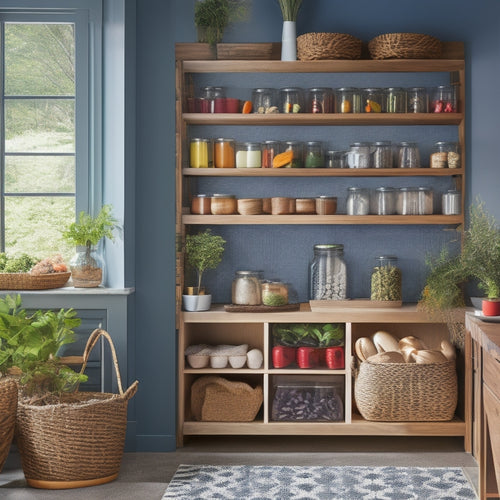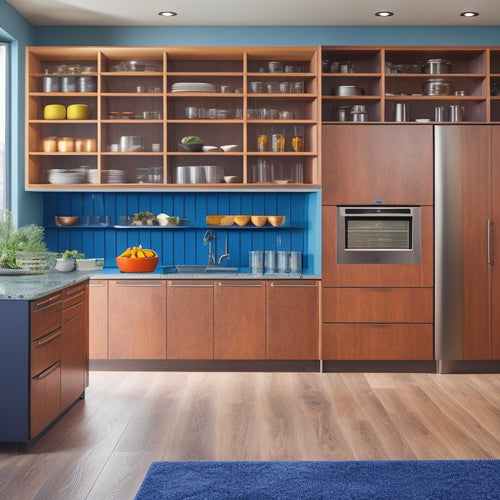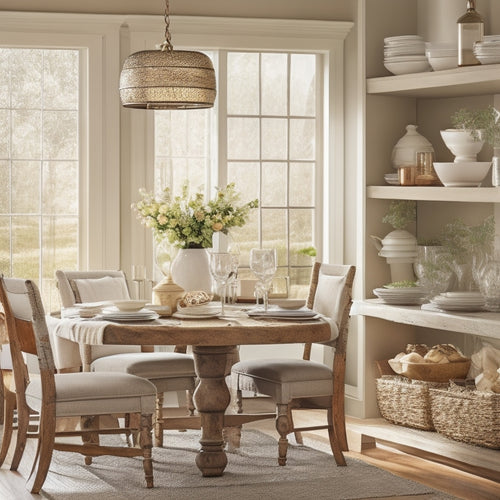
5 Essential Tips for Storing Kitchen Recipes
Share
Set up a dedicated recipe station in your kitchen to keep your recipes organized. Utilize vertical storage space by installing shelves, hooks, or pegboards to store cookbooks, gadgets, and supplies. Organize your recipes by type, such as breakfast, lunch, and dinner, and consider categorizing by cuisine for quick dish selection. Protect your recipes from damage by using protective sleeves or folders, laminating, and storing them in a dry place. Finally, keep your recipes visible by using display boards or magnetic boards, recipe binders, or cookbook stands to reduce kitchen stress. Now, take your recipe organization to the next level by exploring more efficient storage strategies.
Key Takeaways
• Establish a dedicated recipe station in your kitchen with a binder, tabs, and functional elements for streamlined meal prep.
• Optimize vertical storage with shelves, hooks, and pegboards to maximize space and accessibility for cookbooks, gadgets, and supplies.
• Organize recipes by type, such as breakfast or dinner, and further categorize by cuisine for quick dish selection and meal planning inspiration.
• Protect recipes from damage with protective sleeves, lamination, and acid-free paper, and store them in a dry, sunlight-free area.
• Keep recipes visible and easily accessible in the kitchen using display boards, magnetic boards, or binders with tabs and dividers.
Designate a Recipe Station
Designate a specific area in your kitchen as a recipe station, where you can easily access and organize your recipes, cooking utensils, and ingredients. This dedicated space will help you stay focused and efficient while preparing meals for your loved ones.
Start by setting up a recipe binder, where you can store and categorize your favorite recipes. You can also include tabs for notes, shopping lists, and meal planning.
To make your station more functional, consider the decor. Add a few decorative elements, such as a vase with fresh herbs or a framed kitchen quote, to create a welcoming atmosphere. Install a pegboard or a magnetic strip to hang your frequently used utensils, keeping them within easy reach.
A small countertop or a cart can provide additional storage for your recipe binder, cookbooks, and ingredients. By designating a specific area for your recipe station, you'll be able to quickly find the recipes and tools you need, making meal prep a breeze.
Utilize Vertical Storage Space
Make the most of your kitchen's vertical space by installing shelves, hooks, or a pegboard on walls or the back of a door to store infrequently used cookbooks, special occasion dishes, or bulky kitchen gadgets. This will help keep your countertops and floors clear, making it easier to focus on cooking and serving others.
Here are some ways to maximize your vertical storage:
-
Use shelf dividers to separate cookbooks, kitchen gadgets, or baking supplies, keeping them organized and easy to access.
-
Install a magnetic board on the side of a cabinet or fridge to store spices, oils, or frequently used utensils.
-
Hang a pegboard on a wall or door to store pots, pans, utensils, or aprons, keeping them within easy reach.
- Add baskets or bins to shelves or hooks to store dry goods, snacks, or other kitchen essentials.
Organize by Recipe Type
Sort your recipes into categories like breakfast, lunch, dinner, desserts, and snacks to quickly locate the perfect dish for any occasion. This simple step can save you tons of time when meal planning.
You can further categorize your recipes by cuisine categories, such as Italian, Mexican, or Indian, making it easier to find a specific dish. For instance, if you're planning a dinner party and want to serve Italian food, you can quickly flip through your Italian recipe section.
Organizing your recipes by type also helps you identify gaps in your collection. You might realize you have plenty of dinner recipes but lack ideas for healthy snacks. This can inspire you to explore new recipes and cookbooks to fill those gaps.
Protect Recipes From Damage
To safeguard your cherished recipes from splatters, spills, and tears, consider storing them in protective sleeves or folders that can withstand the rigors of frequent kitchen use. You'll want to guarantee your recipes remain legible and intact, even in a busy kitchen environment.
Here are some essential tips to protect your recipes from damage:
-
Laminate your recipes: Apply a clear laminate to prevent moisture damage and fading.
-
Use acid-free paper: Prevent yellowing and brittleness by using acid-free paper for printing or writing your recipes.
-
Store in a dry place: Keep your recipe storage away from humid areas, such as near the sink or stove, to maintain moisture protection.
- Avoid direct sunlight: Place your recipe storage in a spot that receives indirect sunlight to prevent fading prevention.
Keep Recipes Visible
You can easily access and follow your recipes by keeping them visible in a way that works best for your kitchen workflow. This means designating a specific area where you can quickly glance at your recipes while cooking.
Consider using a display board or a magnetic board on your fridge to hold your recipe cards. This way, you can easily swap out recipes as needed and keep your most frequently used ones within easy reach.
You can also use a recipe binder or a cookbook stand to keep your recipes visible while you cook. These tools allow you to keep your recipes at eye level, making it easy to follow along as you prepare a dish.
Additionally, consider using tabs or dividers to organize your recipes by course or ingredient, making it simple to find the recipe you need in a pinch. By keeping your recipes visible, you'll save time and reduce stress in the kitchen, allowing you to focus on what matters most - serving delicious meals to your loved ones.
Frequently Asked Questions
How Do I Prevent Recipe Cards From Becoming Cluttered and Messy?
"Imagine your grandmother's treasured recipe cards, now yellowed with age, but still cluttered with notes and stains. To prevent this, you'll organize your cards by category, maximizing space with tabbed dividers and a compact storage box, keeping them tidy and easily accessible."
Can I Store Recipes on My Computer or Phone Instead of Physically?
You can ditch the clutter and go digital! Store your recipes on your computer or phone using digital organization tools and cloud storage, allowing you to access and update them easily from anywhere.
What's the Best Way to Store Recipes With Lots of Images or Graphics?
When storing recipes with lots of images or graphics, you'll love digital scrapbooking for visually organizing your collection. Create digital albums or folders with clear labels, and easily access your recipes with a glance, freeing up physical space and reducing clutter.
How Often Should I Review and Update My Stored Recipes?
You should regularly review and update your stored recipes to guarantee a recipe refresh, reflecting your culinary evolution and growth. Aim to revisit and refine them every 6-12 months to keep your collection fresh and relevant.
Can I Store Recipes in a Binder With Other Household Documents?
"Coincidentally, you're already organized with household documents, so why not store recipes in a binder too? Create a labeling system and tab organization to separate cooking categories, making it easy to access your favorite dishes and household files."
Related Posts
-

Sliding Pantry Storage Ideas for Renters
If you're looking to optimize your rental kitchen, sliding pantry storage solutions could be your answer. Employ vert...
-

Roll-Out Trays for Modular Kitchen Cabinets
Roll-out trays are the perfect addition to your modular kitchen cabinets, enhancing both accessibility and organizati...
-

Corner Cabinet Storage for Dinnerware Sets
Corner cabinet storage for dinnerware sets can change your kitchen into an organized, stylish space. By utilizing ver...


